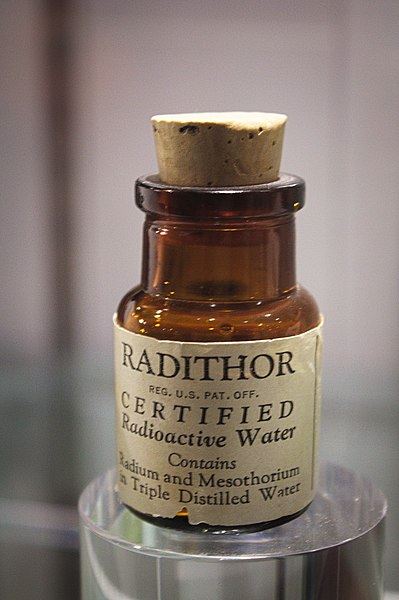by Haley Brinker
 The story of radium began in the laboratory of Marie Curie and her husband, Pierre, in 1898. It was there that they discovered the power of this element, a discovery that would earn them a Nobel Prize in Physics [1], but radium’s story was just beginning. Soon, the entire world would be at rapt attention, hungry for any news of or product containing what some called a “miracle element” [2]
The story of radium began in the laboratory of Marie Curie and her husband, Pierre, in 1898. It was there that they discovered the power of this element, a discovery that would earn them a Nobel Prize in Physics [1], but radium’s story was just beginning. Soon, the entire world would be at rapt attention, hungry for any news of or product containing what some called a “miracle element” [2]
By the early 1900s, radium was synonymous with health. Products of all kinds, touting the benefits of radium for the human body were everywhere. Radium water was incredibly popular and one company, Bailey Radium Laboratories, called far and wide that their product, Radithor, was the tonic to cure to all of the public’s bodily ills [3]. It was even picked up by a celebrity sponsor of sorts, Eben MacBurney Byers. He loved Radithor so much, and spoke its praises so highly, that he consumed over a thousand bottles in only five years [3]. There were radioactive toothpastes, radioactive makeup, and even entire spas dedicated to the healing power of radium [1]. One product, the Radio-Active Pad, even claimed that it could cure blindness (yes, blindness) by wearing the pad “on the back by day and over the stomach at night” [4]. Consumers at the time were spoiled for choice. They could have their radium in the form of a kissable pout with lipstick. They could spend a day with the girls, lavishing in a lush spa, cucumbers covering their eyes, while they received treatments enhanced with the restorative powers of this wondrous cure-all.
Radium in branding was so popular, in fact, that some companies simply named their companies after it but did not actually put any into their products. One of these companies was called “Radium Brand Creamery Butter,” which didn't likely contain any of its namesake element [4]. Where people today would jump at products labeled ‘organic’ or ‘gluten free,’ folks during the radium craze lunged for any product that claimed it was associated in any way with radium. This was the power of popularity. Radium was trendy; radium was chic.
Like all fads, the public’s love affair with radium would not last forever. Stories around the world began circulating, highlighting the serious health problems of those who were ingesting radium. Our Radithor loving, celebrity endorser, Eben MacBurney Byers, was soon afflicted with a host of health problems. After five years and over a thousand bottles of Radithor, the radium in his system had caught up with him. An attorney, Robert Hiner Winn, went to interview Byers in 1930 on behalf of the Federal Trade Commission. When he met Byers, he was dumbfounded; this previously hardy and healthy man was now a shadow of his former self. Byers’ radium poisoning was so severe that “half of his face was missing” [3]. The health tonic Byers had spent years promoting and using had been his downfall. He had been misled, and he was not the only victim.
During the peak of radium mania, the US Radium Corporation had set up factories to produce watches with glow in the dark dials. These dials were hand painted using radium laced paint by young women who, to keep the numbers crisp and precise, pointed the tips of their brushes with their lips. Each lip-pointed brush stroke was “slowly irradiating” the women “from within.”. Soon, the women began to come down with symptoms of radium poisoning [2]. Bright, young women attempting to make a good living became bed-ridden, in worse health than most septuagenarians, and they had not even reached the age of thirty.
With these two stories, and a plethora of others, the world turned its back on radium. The government, namely the U.S. Food and Drug Administration, outlawed any patent medicines that had radium as an ingredient [2]. Ingesting radium as medicine became a thing of the past, a bad memory in the public consciousness. Its popularity and downfall give meaning to the phrase that anyone eyeing a product that seems to good to be true should remember: buyer beware.
Bibliography
[1] Crezo, Adrienne. “9 Ways People Used Radium Before We Understood the Risks.” Mental Floss. Mental Floss, October 9, 2012. https://www.mentalfloss.com/article/12732/9-ways-people-used-radium-we-understood-risks.
[2] Moss, Matthew. “The Radium Craze – America's Lethal Love Affair by Matthew Moss.” The History Vault. The History Vault, January 15, 2015. https://thehistoryvault.co.uk/the-radium-craze-americas-lethal-love-affair-by-matthew-moss/.
[3] Brumfield, Dale M. “The Blessings of Radium Water Made His Head Disintegrate.” Medium. Medium, March 18, 2019. https://medium.com/lessons-from-history/the-blessings-of-radium-water-made-his-head-disintegrate-3ac052cb8620.
[4] Orci, Taylor. “How We Realized Putting Radium in Everything Was Not the Answer.” The Atlantic. Atlantic Media Company, March 7, 2013. https://www.theatlantic.com/health/archive/2013/03/how-we-realized-putting-radium-in-everything-was-not-the-answer/273780/.